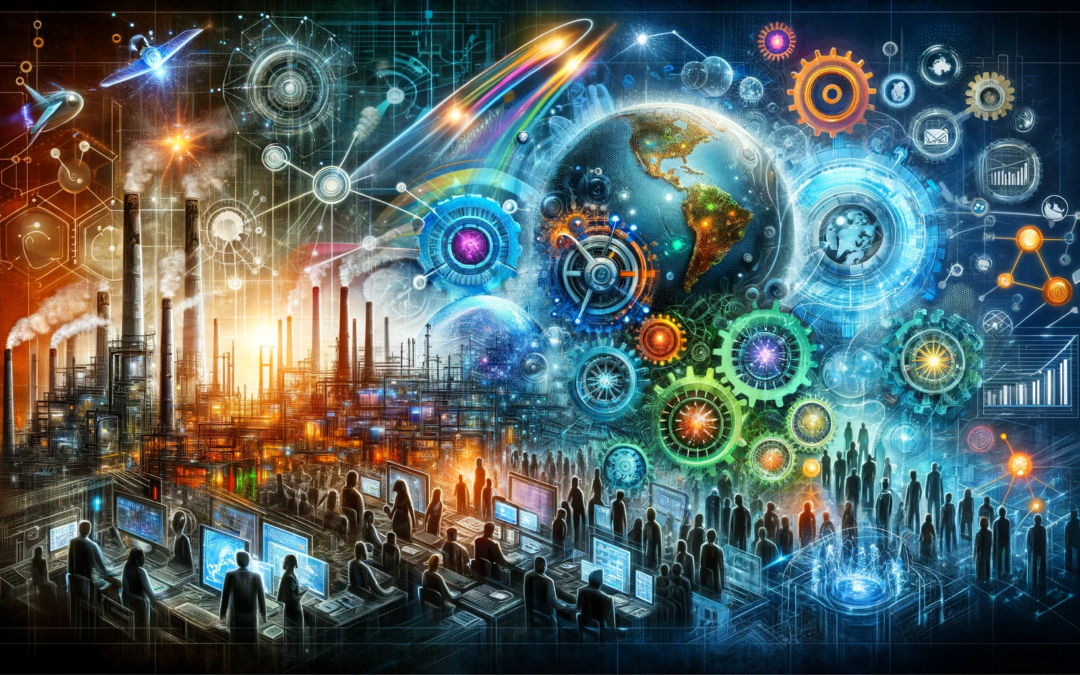Industry 4.0 is not just revolutionizing industrial production; it’s fundamentally altering the economic landscape and workforce dynamics globally. This second part of our series delves into how Industry 4.0 is reshaping economies, transforming manufacturing processes, and redefining the workforce.
Economic Transformation: Global Economic Shifts
Industry 4.0 technologies are changing the nature of global trade, supply chains, and economic power dynamics. It’s like a game of economic musical chairs, with countries scrambling to secure their seats in the digitalized economy. The shift towards a more interconnected, digitalized economy has profound implications for businesses and nations alike. It’s a race to adapt or risk being left behind.
Revolution in Manufacturing
Industry 4.0 is not just about robots taking over the assembly line; it’s about transforming the entire manufacturing process. The emergence of smart factories is changing the game, with machines communicating and collaborating in ways we never thought possible. It’s the rise of the machines, but don’t worry, they’re not here to terminate us; they’re here to make our lives easier. Increased automation, efficiency, and customization are the name of the game.
Supply Chain Innovation
Gone are the days of supply chain mysteries and inefficiencies. Thanks to Industry 4.0, supply chain management is getting a much-needed makeover. It’s all about resilience, transparency, and efficiency. With the help of technologies like the Internet of Things (IoT) and blockchain, supply chains are becoming more interconnected and streamlined. No more lost packages or shady dealings; it’s a brave new world of supply chain innovation.
Workforce Evolution: Job Displacement and Creation
Now, let’s address the elephant in the room: job displacement. Yes, automation and AI are taking over some jobs, but fear not! Industry 4.0 is also creating new job opportunities. Sure, some traditional manufacturing jobs may disappear, but new roles in data analysis, system maintenance, and AI ethics are emerging. It’s a game of musical chairs again, but this time, there are enough chairs for everyone.
Skill Adaptation and Education
With the rise of Industry 4.0, the workforce needs to adapt. The skills required in this new era are different, and that’s where upskilling and reskilling initiatives come into play. Educational institutions have a crucial role in preparing the workforce for the changes brought by Industry 4.0. It’s time to hit the books and learn some new tricks.
Challenges and Opportunities: Navigating Industrial Transition
Transitioning to Industry 4.0 is not all rainbows and unicorns. There are challenges, like technological adoption, cybersecurity, and ethical considerations. But fear not, brave business owners! There are strategies to navigate these challenges and come out on top. Embrace the change, secure your systems, and always remember to be ethical. It’s a wild ride, but the rewards are worth it.
Economic Growth and Innovation
Industry 4.0 presents exciting opportunities for economic growth, innovation, and sustainability. It’s like a treasure trove waiting to be discovered. Businesses and governments can leverage these technologies to create a better future for all. It’s time to think big, dream big, and make big things happen.
Conclusion
Industry 4.0 is a game-changer, shaking up economies and workforce dynamics worldwide. It challenges the status quo while offering tremendous potential for economic and workforce advancements. As we wrap up this part of the series, remember that Industry 4.0 is a double-edged sword. It brings both challenges and opportunities. Stay tuned for the next part, where we’ll explore the societal implications and ethical considerations of this industrial evolution. Brace yourselves, folks; we’re just getting started.
This part of the series provides a comprehensive overview of the profound changes Industry 4.0 is bringing to economies and workforces worldwide. It aims to offer balanced insights into the challenges and opportunities this revolution presents, equipping readers with a nuanced understanding of what these shifts mean for the future.










